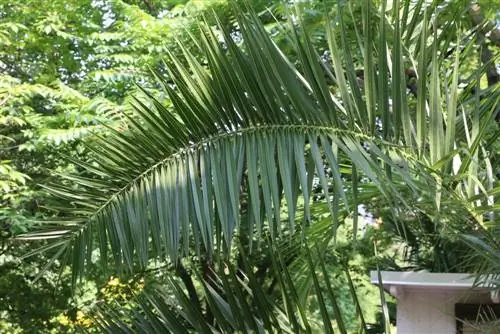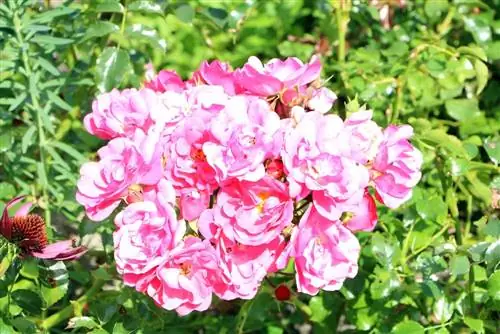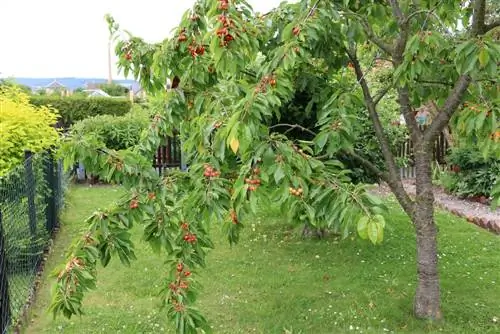- Author admin [email protected].
- Public 2023-12-17 03:39.
- Last modified 2025-01-24 12:45.
Palm trees in the snow; This picture is becoming more and more common in the local regions. In fact, the diverse palm family is home to a number of species and varieties that can withstand frost and snow. If fundamental premises are met, such as the optimal location, the appropriate type of palm tree and adequate winter protection, the ambassadors of southern flair will also thrive in your green kingdom. The following instructions explain specifically how to plant palm trees in the garden and repot them correctly in pots.
Planting palm trees in the garden
So that the dream of having a palm tree outdoors comes true, the focus is on choosing a suitable species or variety in advance. This results in the choice of location and the planting work can begin. The following guide will provide you with the tools you need to successfully complete this gardening challenge:
Frostproof Palms
These species and varieties have already proven themselves excellent for year-round outdoor cultivation in beds and containers:
Needle palm (Rhapidophyllum hystrix)
This palm holds the title of the most winter-hardy palm in the world. Decorative leaf fans rise above a short trunk, forming a mighty tuft. The upper sides are shiny green, while the undersides of the leaves shimmer silver.
- Growth height up to 250 cm
- hardy down to -24 degrees Celsius
Chinese hemp palm (Trachycarpus fortunei)
A particularly representative palm tree moves into your garden with this powerful specimen. The slender trunk is covered with a dense layer of fibers. Above it sits a huge crown of leaves with stiff fronds that even stormy winds cannot harm.
- Growth height up to 12 meters
- hardy down to -17 degrees Celsius
Dwarf palm (Chamaerops humilis 'Vulcano')
Perfectly suitable for small gardens and pots, the dwarf palm scores with its compact habit. The feathery green leaf fans form a dense tuft over a thornless trunk.
- Growth height up to 300 cm
- hardy down to -15 degrees Celsius
This small selection may serve as inspiration when looking for the ideal palm tree for your garden.
Tip:
Palm trees that are at least 4 years old and have a height of 50 centimeters are more suitable for outdoor cultivation than smaller or younger specimens.
Location
So that palm trees feel comfortable in your garden, a location with the following conditions should be considered:
- Full sunny location, preferably 1-3 meters from a heated building
- Protected from wind and rain, in the shelter of a wall or a hedge
- Humose soil, preferably loamy-sandy and not too dry
- Loose and well-drained, without risk of waterlogging
- Ideally with a pH value of 5.3 to 7.0
A place in the immediate vicinity of the house - not necessarily on the weather side - is therefore desirable if you plant palm trees in the garden.
Acclimatize
Once you have chosen your favorites among the hardy palm trees, they require some time to get used to them in the open air. Most of the plants were cultivated behind glass, like large greenhouses, and spent a long period of time in hardware stores and garden centers with little light. Directly confronted with the blazing sun, the palm trees suffer from sunburn. Although this is not life-threatening, it still significantly damages the optics. Choose from one of the two alternatives to help the plants acclimatize in the garden:
- Plant in the chosen location immediately after purchase and shade it with a parasol for a week
- Hard off in a pot for one to two weeks in a partially shaded place and only then plant out
Planting instructions
If hard frost periods are no longer expected in spring, you can plant palm trees in the garden from March. In this way, the plants have enough time to root themselves well in the soil and produce new leaves. Follow these steps:
- Dig a planting pit with twice the volume of the root ball
- Enrich the excavation with compost, peat, leaf mold, horn shavings and, if necessary, some sand
- In wetter locations, drainage made of grit prevents harmful waterlogging
- Pour the optimized excavation or special palm soil on top in a 15 cm high layer
- Unpot the palm tree, place it in the middle of the planting hole and plant it
At the end, the root ball should be just as deep in the substrate as it was in the pot. Ideally, the tree disc is located a few centimeters below the surrounding earth surface. This watering edge optimizes the utilization of the irrigation water. Water regularly and abundantly during the growing phase to support rooting.
Repotting palm trees in pots

If your palm trees have survived the cold season well in a protected location in the garden or winter quarters, the best time to move to a larger pot begins in spring. This is necessary when the taproots take up all the available space, are already pushing up through the substrate or are growing out of the opening in the ground. Choose the new planter just a few centimeters larger in diameter and depth. Otherwise, the palm will initially invest all of its energy in rooting through the new pot. This process occurs at the expense of height and leaf growth. How to repot correctly:
- Create a drainage system using grit or pottery shards above the water drain in the ground
- An air and water permeable fleece prevents soil crumbs from getting stuck here
- Fill the lower third of the bucket with high-quality palm soil
- Alternatively, make a mix of 1 part each of compost, garden soil and peat
- Additives such as perlite, expanded clay, sand or polystyrene beads improve permeability
- Place the potted palm tree in the middle of the pot and surround it with substrate
As you pour in the substrate, press it down repeatedly with your fist to prevent voids from forming. A watering edge of 3-4 centimeters prevents wet soil from spilling over later. Last but not least, pour thoroughly.
Tips for winter protection
To ensure that palm trees in beds and pots are not damaged in winter, the following precautions are recommended.
- Cover the root area thickly with leaves, straw, coniferous twigs or bark mulch
- Loosely tie the leaves together into several scoops using raffia or sisal
- In severe frost, wrap the trunks with jute or reed mats
- Cover the bucket with bubble wrap and place it on wood or Styrofoam
- Pack small palm trees completely in fleece or foil with a hand's width distance from the crown and trunk
- As soon as the temperatures rise, remove all winter protection immediately
In regions with consistently hard winter frosts, prudent hobby gardeners prevent possible damage when planting in the garden. To do this, a square planting hole is dug that is 30 centimeters larger in width and depth than the root ball. The walls of the pit are lined with 5 centimeter thick rigid foam panels. However, the floor must not be covered with the material. In this way you create a self-made insulating bucket. Then plant the palm tree as described.
Watering in cold frost
All efforts to successfully overwinter palm trees in the garden are ineffective if the plants dry out. In fact, far more plants suffer from drought stress in winter than in summer. If frost occurs during the cold season, the temperatures will be below zero, while at the same time there will be no insulating snow cover. Since the roots in the frozen ground cannot access liquid water and there is no supply from above, they are in danger of drying out. On frost-free days, the palm trees in the garden and in the pot should be watered.
Conclusion
If you want to give your garden an exotic touch, you can easily plant palm trees in the garden. There is a wide range of hardy species and varieties available to you, all of which tolerate the lowest temperatures. By choosing a sunny, protected location in slightly acidic garden soil, the prospects for successful cultivation are excellent. If you plant according to these instructions, the tropical gems will happily take root. Those who prefer to cultivate palm trees in planters can create a relaxing holiday feeling on their terrace and balcony all year round. However, every few years a change to the next larger pot is unavoidable. This reading material gives you the tools to properly repot palm trees in pots. Since winter is the ultimate challenge for all palm trees outdoors, the tips for winter protection would like to help you enjoy the majestic plants for many years to come.






